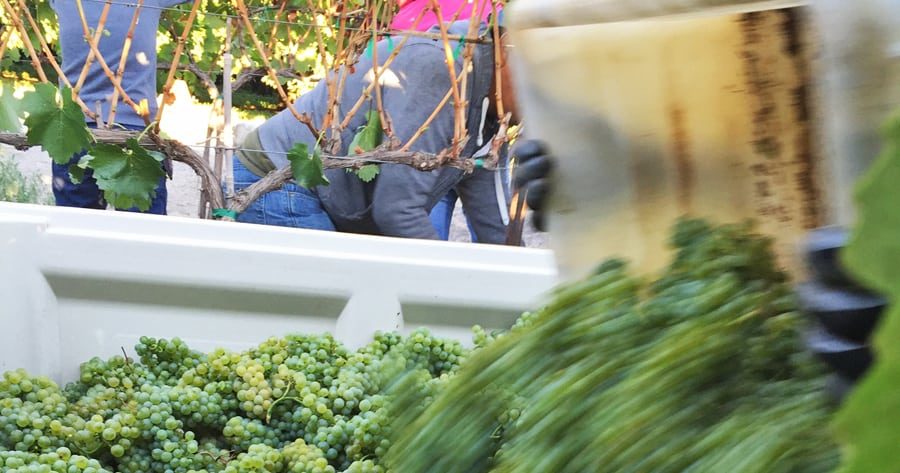
Home » Cab reigns as king in state’s record wine grape harvest
Cab reigns as king in state’s record wine grape harvest

March 15, 2017
By Wine News Service
As expected, the Washington wine industry’s 2016 harvest for grapes was a record.
The Washington State Wine Commission released statistics in early March, and the report showed a record crop of 270,000 tons harvested last fall, easily eclipsing 2014’s record of 227,000 tons.
[blockquote quote="Cab is still king." source="Kevin Corliss, Ste. Michelle Wine Estates" align="right" max_width="300px"]
Leading the way was Cabernet Sauvignon at a stunning 71,100 tons, making it by far the king of Washington wine.
“That’s a lot,” said Kevin Corliss, vice president of vineyard operations for Ste. Michelle Wine Estates. “I knew it was going to be big.”
Cab now makes up 26 percent of the state’s total production and is the first grape to crack 70,000 tons in one season. That figure surpasses the state’s entire crop from 1999.
Corliss has a good handle on the state’s grape crop because Ste. Michelle uses two out of every three wine grapes grown in Washington. He said Cab acreage increased a bit more than 5 percent last season. This doesn’t include vineyards coming into full production, something that takes up to four years after vines are planted.
“What we see going forward is steady growth,” he said. “Cab is still king.”
Intrinsic Wine Co., a new label from Ste. Michelle Wine Estates made at Columbia Crest in Paterson, focuses entirely on Cabernet Sauvignon. Demand for the wine has been so high, it already has exceeded 100,000 cases of production in its third vintage. That’s the equivalent of nearly 1,700 tons of fruit.
Columbia Crest makes 370,000 cases of Cabernet Sauvignon, and 14 Hands in Prosser makes 500,000 cases of Cabernet Sauvignon.
Chateau Ste. Michelle makes nearly a half-million cases of Cabernet Sauvignon at its Canoe Ridge facility west of Paterson.
Most of its Cab grapes come from the Horse Heaven Hills.
Following Cab is Merlot, with 48,400 tons, up from 3,200 tons the previous year. Syrah is the No. 3 red grape in Washington, at 21,300 tons, up from 16,000 tons in 2015
Both Merlot and Syrah have been difficult sells on store shelves in recent years, so some might scratch their heads over this increase. Bob Bertheau, head winemaker for Chateau Ste. Michelle — the state’s largest and oldest winery — explained both of those grapes are useful in blends.
“I view them as universal donors,” he said, indicating they help soften Cabernet Sauvignon, making it a better wine, a tradition going back to European winemaking.
From a logistics standpoint, having a little Merlot and Syrah in each new vineyard planting is smart, Corliss said. Both grapes tend to ripen early in September, so getting them fermented and out of the way when the onslaught of Cabernet Sauvignon starts coming in is easier on the wineries.
For white wines, Chardonnay reigns. Last fall, winemakers brought in 45,000 tons of Chardonnay compared with 42,000 the previous year.
Meanwhile, Riesling continues to retreat, with 41,300 tons harvested last fall compared with 44,100 tons the previous year.
Corliss said Chardonnay is growing at a slow, steady rate. The drop in Riesling, he said, is expected and he believes that the amount available in Washington is balanced with what consumer demands are.
For the first time, Bertheau said, Chateau Ste. Michelle’s production of Columbia Valley Chardonnay is the same as his Columbia Valley Riesling production: around 900,000 cases. He said, “We’re on pace with consumer demand.” He added that red wine production at Ste. Michelle is keeping pace with the right wine production: about a 3-to-1 ratio.
The growth is being led by plantings in the Horse Heaven Hills. Leading the way, of course, is Cabernet Sauvignon with nearly 6,700 acres in the Horse Heaven Hills having doubled since 2009. Where red wine acreage and Horse Heaven’s top 10,000 acres in 2016 for the first time, white wine acreage crept up to nearly 4,000 acres, led by Chardonnay.
Part of Corliss’s job at Ste. Michelle used to keep his crystal ball clean.
“We look at a 10-year supply-and-demand horizon,” he said.
Based on his projections, Cab probably will not crack 10,000 tons next year.
He said winter damage from this year’s large amounts of snow in the Columbia Valley did not look too bad. Bud damage is slight and limited to young vines, which can easily be retrained.
Corliss seems slightly surprised by the slow growth in Malbec, which jumped from 2,400 tons in 2015 to 2,700 tons last fall. He attributed that to the fact that most Malbec is in high-tier programs, therefore tonnage per acre is naturally lower. He expects Malbec to continue to rise in popularity in tonnage in years to come.
Local News
KEYWORDS march 2017




